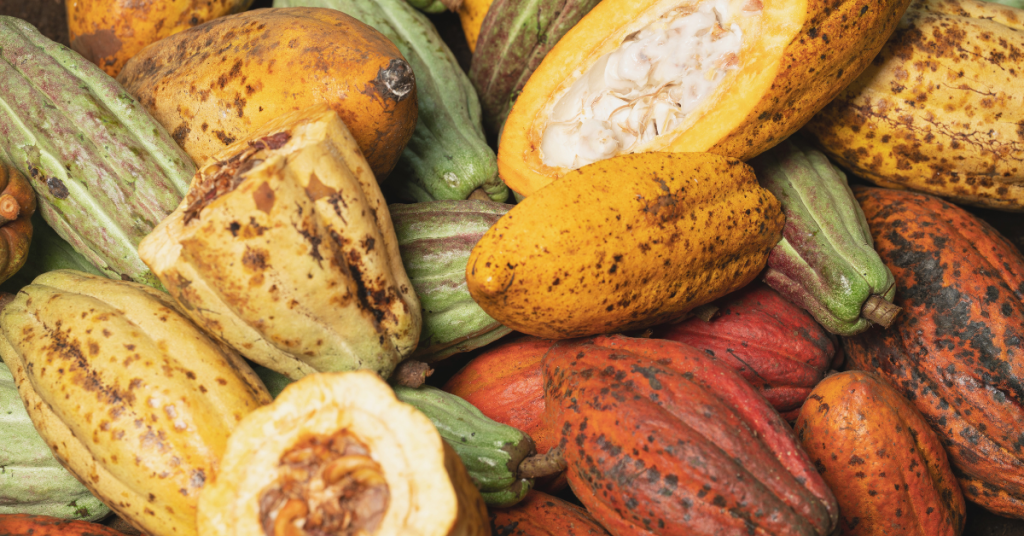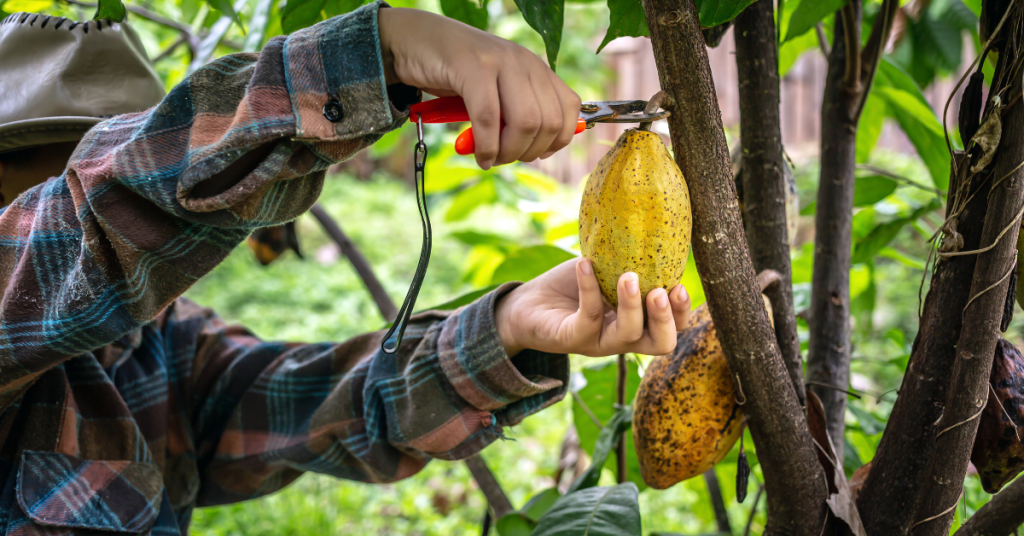Discover the bitter truth behind how chocolate is made—its hidden costs, ethical dilemmas, and the impact on farmers and the environment.
The first time I learned where chocolate came from, I was sitting in my grandmother’s backyard, holding a cacao pod the size of a football. She split it open almost effortlessly, revealing seeds wrapped in pale, fibrous flesh. It smelled faintly of citrus.
I grew up watching her dry cacao beans under the sun. She roasted them in an old cast-iron pot, ground them using a manual grinder, and molded the thick paste into tablets called tablea. These would later dissolve into steaming mugs of sikwate, the Filipino version of hot chocolate, or be stirred into a pot of champorado, thick rice porridge sweetened with condensed milk. At the time, I assumed all chocolate was made that way, in small batches by patient grandmothers, using old knives and stone grinders and years of practice.
It is not.
The chocolate bars we buy today have a different story behind them.
In this article, we will explore how chocolate is made, from the cacao pod to the chocolate bar, and reveal some surprising and uncomfortable truths about the process. By the end, you’ll gain a new perspective on the global chocolate industry—its intricacies, its injustices, and the steps we can take as consumers to support ethical practices.
The Brutal Reality of Cocoa Farming

The Ivory Coast is where 40% of the world’s cocoa comes from. Cocoa makes up about 15% of the country’s GDP, yet two-thirds of its people rely on cocoa farming, often struggling to make ends meet.
Netflix’s Rotten lays this bare in the episode Bitter Chocolate, taking us to the core of the cacao supply chain. It reveals the gap between the lives of farmers and corporate executives. While the people who harvest the cocoa toil in poverty, the executives sit in the lap of luxury.
Bitter Chocolate follows cocoa from farm to factory, shedding light on the true price we pay for our love of chocolate. It shows the cost of the sweet life. The farmers who grow the cocoa barely make ends meet. They’re stuck in a system where the value of their work is a pinch of what the chocolate costs in stores.
Who Enjoys the Profits?
Most of us don’t have the expertise or the stamina to produce our own chocolate. It was the same for the early Spanish who first set foot in the New World, soon getting accustomed to their cup of cocoa. The Aztecs had a vast network of trails, transporting beans from cacao-rich areas in southern Mexico to their capital, Tenochtitlán. Cocoa, much like gold, became a currency, a luxury, and a commodity that invited all kinds of violence and oppression. And somehow, it’s still that way today.
After cocoa is harvested, it changes hands multiple times. Farmers sell to local traders, who sell to exporters, who sell to manufacturers. Each intermediary takes their cut, but no one bears the weight of production as the original farmer does. And as it passes from one party to the next, the cost gets inflated. Why? Because the farmers at the bottom aren’t the ones with the power.
Who’s Getting the Real Chocolate Cake?
The farmers at the bottom of the pyramid are tired, overworked, and underpaid. Many of them are earning less than a dollar a day, despite the cocoa industry generating over $100 billion globally. The workers who supply the raw materials, often on the brink of poverty, remain trapped in a cycle of dependency.
Then, as you move up the pyramid, things get a little more complicated. Middlemen profit off the movement of the beans, taking their cuts for handling the cocoa, transporting it, storing it, and marketing it. Their businesses live off what’s essentially the sweat of others’ work.
At the very top of the chain are the multinational corporations—the ones who manufacture the chocolate. Companies like Hershey, Nestlé, and Mars sit comfortably at the apex, making billions, often with little regard for the realities at the bottom.
When cocoa prices fluctuate on the international markets those who profit the most are the ones who are the furthest removed from the actual work. Big chocolate companies are not affected by price drops. They buy cocoa at a lower price, save money for themselves, and keep the price the same for consumers. Meanwhile, the farmers get paid less for their work.
Child Labor, Slavery, and Environmental Destruction

Cocoa is a precious commodity. Once it’s transformed into chocolate, it’s considered a luxury item for the masses. But at its origin, it’s a product of exploitation.
We often picture crowded factories or grim sweatshops when we hear about forced labor. But in the cocoa industry, it’s hidden in plain sight. Kids—some just 10 years old—get caught in a vicious cycle of abuse and exploitation, with no easy way out. They’re made to work long hours in dangerous conditions, with little hope for an education or a future beyond the cocoa trees.
Even worse, these children aren’t just helping out—they’re holding up the whole industry, working for farmers who can’t afford adult labor. They’re carrying the weight of the world on their small shoulders. And it’s not just limited to the Ivory Coast; the problem stretches across West Africa, affecting cocoa production in Ghana and other regions.
It’s a brutal reality that governments and international organizations have failed to eradicate. Child labor is still a reality, despite agreements like the Harkin-Engel protocol and big chocolate companies’ promises. Groups like Fairtrade and Rainforest Alliance are trying to help, but their solutions often miss the mark—too tangled to turn the tide.
But child labor isn’t the only issue. Cocoa farming has caused a huge environmental problem. Since 1990, the Ivory Coast has lost about 85% of its forests. Farmers are being forced to clear the forests to plant more cocoa. The trees that once protected the land, supported wildlife and helped the environment are being destroyed bit by bit.
Why? Because as demand for cocoa grows, so does the pressure on farmers to produce more. The solution, however, isn’t as simple as increasing yields. As production rises, so do the costs. And the prices farmers receive for their cocoa often don’t reflect the true cost of the labor and environmental destruction involved.
Balancing Survival and Sustainability
The toughest decision for farmers is w to keep clearing forests for cocoa or protect what’s left and risk not having enough food. If you’re a farmer in rural Ivory Coast, with your family depending on you, you don’t have the luxury to think about the environment. Survival comes first.
It’s not as simple as blaming the cocoa producers for their role in the environmental destruction. There is a bigger problem: a system that traps people in difficult situations. While large companies make money from cocoa, the farmers who grow it stay trapped in poverty.
Does Ethical Chocolate Exist?
The chocolate industry is starting to catch up to ethical coffee brands focusing on direct trade and sustainability. Brands like Tony’s Chocolonely are working to make chocolate 100% slave-free. They work directly with farmers and ensure the whole process—from bean to bar—is fair and open. While they’re still a small part of the industry, these companies are leading the way for a more ethical and transparent chocolate market.
